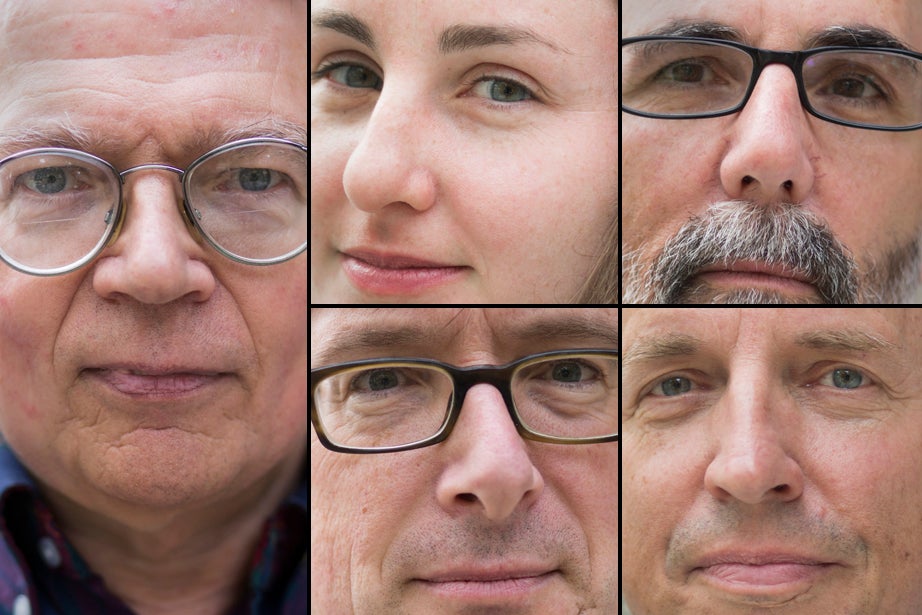German doctors killed Anna Weiss as part of a Nazi euthanasia program directed at individuals they classified as disabled.
The woman’s so-called disability, as recorded in trial documents: being an “unsympathetic Czech Talmudic Jewess.”
“That ‘unsympathetic’ woman deserved to be named,” said Matt Seccombe, who has been the primary analyst for Harvard Law School Library’s Nuremberg Trials Project. “In these mass atrocities, the names become numbers. They deserve to have their names recorded and remembered.”
In 1949, four years after the Nuremberg war crime trials began, the library received the most complete set of documents from the Nazi prosecutions outside that of the National Archives. Over the years, individuals who participated in the 13 trials have also donated their personal papers related to the cases. In 1998, the library initiated the Nuremberg Trials Project with the goals of preserving the entire collection and making it accessible online. To date, Seccombe has analyzed five trials, including thousands of documents, while scanning teams have digitized the 154,000 transcript pages and nearly 600,000 document pages for all the trials.
The recently relaunched website allows everyone from scholars and researchers to casual history buffs to access the materials. These include the transcripts and descriptions of all documents from trials one through four and seven, as well as fully viewable document pages from trials one, two, and four. The new site includes keyword-searchable full-text transcripts and enhanced viewing of documents and transcripts. The library, which has relied on donations to support the project, will publish materials from the remaining trials as more funding becomes available.
Stephen Chapman, manager of the project scanning teams, said his sense of responsibility to the project only increased as he spent more time with the documents.
“What really gives me pause is thinking about the obligation,” he said. “I have a sense of duty that I want to make sure we present comprehensive, authoritative copies. We can’t afford to leave anything out.”
Along with Chapman and Seccombe, the small team on the project includes digital archivist Kerri Fleming, web developer Paul Deschner, and curator of modern manuscripts Edwin Moloy.
From the very start, Seccombe expected to struggle with the materials. In a few documents the horror is explicit, he said, while many others couch the savagery of the crimes in bureaucratese. Describing the latter, he recalled long days poring over a letter sent to Heinrich Himmler, head of the Nazi special police force, by a doctor proposing the chemical sterilization of inmate workers in concentration and labor camps. Himmler wrote in the margin: “Dachau,” the first concentration camp established in Germany.
“Seeing it in the letter is really striking,” Seccombe said. “By writing his instructions on that document, he set the crime in motion.”
Fleming began work on the project in 2014 as a digitization specialist, removing staples and paper clips from the fragile documents so they could be photographed through a high-speed scanner. Seeing the trial typescripts and evidence photographs carefully conserved after having been bundled up in boxes for decades made the work compelling and gratifying.
She was stunned, though, at first glimpsing Hitler’s signature, and had a similar reaction to a giant organizational chart illustrating the power structure of the Nazi regime.
“It was so clinical, and I couldn’t help thinking about how easy it is to make a chart,” Fleming said. “At times I felt it was too much for me to handle. One of the last boxes I opened had pictures from the concentration camps. It was startling and caught me off guard. There are a million stories that will never be told, so getting the names is really important.”
Analyzing a document can take 10 minutes or 10 hours, depending on the complexity of the material and time needed to decipher handwriting and obscure details, and to identify the key persons involved. For Seccombe, several have had “a haunting effect.”
“I had four nightmares out of five trials,” he said. “Quite a few times I was glad to walk away for a while, in order to avoid burnout.”
One hard-to-shake document was a report by Lt. Walther, a Nazi who oversaw the killing of more than 100 Jews and gypsies in Yugoslavia. The officer described how quickly his men had done the killing on the first day, before hesitating the next.
“He had followed his military orders, but at the end of the report, he said he wondered how he’d feel another night alone in his quarters. That’s going pretty deep into the perpetrator’s mind,” Seccombe said.
Such intense attention to the details has prompted profound conversations among staffers. Often they find themselves asking, “What would I do in these situations?”
“I don’t know how we can say, with certainty, what we would have done had we grown up in that period, and all of our peers had been in the Hitler Youth and in school we had been immersed in official party ideology,” said Deschner.
“I do a gut check,” said Seccombe. “There are things I might do and things I would refuse to do.”
The soul-searching underscores the genuine personal connection Seccombe has made with the lives he has researched in the Nuremberg collection. He found a model of himself in a personnel document on a Nazi deemed unreliable by higher-ups.
“This man was supposed to go straight home at the end of the day to be a good Nazi husband and father. Instead he would wander around town, looking at this and that, and indulging his curiosity,” said Seccombe, who also has a spirit of inquisitiveness.
“They didn’t get rid of him, but would have been happy to see him leave. It confirmed to me that I would have been a bad Nazi and they would have known it.”
This article originally appeared in the Harvard Gazette on October 26, 2016.
***
